Input interpretation

1-octyn-3-ol
Chemical names and formulas
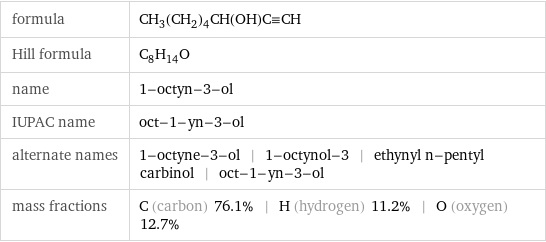
formula | CH_3(CH_2)_4CH(OH)C congruent CH Hill formula | C_8H_14O name | 1-octyn-3-ol IUPAC name | oct-1-yn-3-ol alternate names | 1-octyne-3-ol | 1-octynol-3 | ethynyl n-pentyl carbinol | oct-1-yn-3-ol mass fractions | C (carbon) 76.1% | H (hydrogen) 11.2% | O (oxygen) 12.7%
Lewis structure
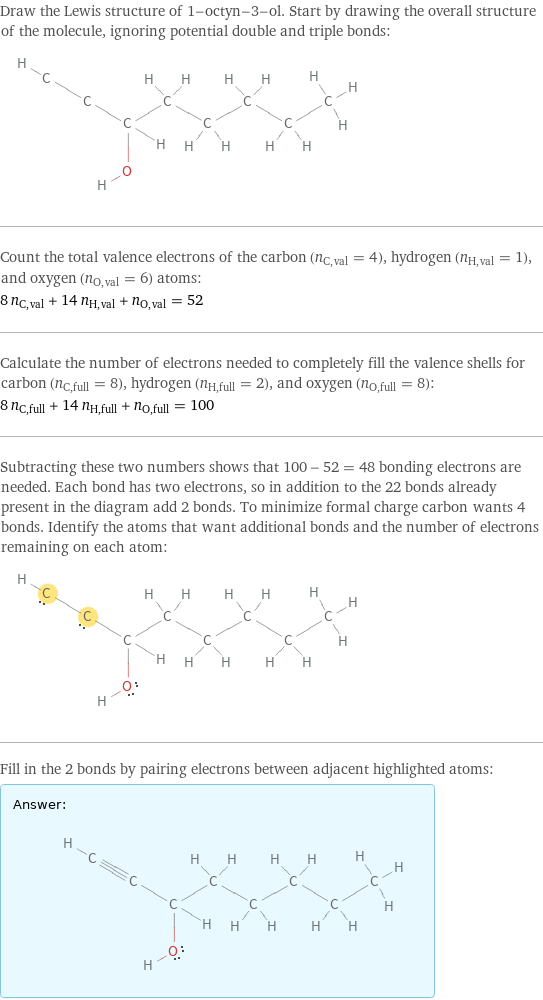
Draw the Lewis structure of 1-octyn-3-ol. Start by drawing the overall structure of the molecule, ignoring potential double and triple bonds: Count the total valence electrons of the carbon (n_C, val = 4), hydrogen (n_H, val = 1), and oxygen (n_O, val = 6) atoms: 8 n_C, val + 14 n_H, val + n_O, val = 52 Calculate the number of electrons needed to completely fill the valence shells for carbon (n_C, full = 8), hydrogen (n_H, full = 2), and oxygen (n_O, full = 8): 8 n_C, full + 14 n_H, full + n_O, full = 100 Subtracting these two numbers shows that 100 - 52 = 48 bonding electrons are needed. Each bond has two electrons, so in addition to the 22 bonds already present in the diagram add 2 bonds. To minimize formal charge carbon wants 4 bonds. Identify the atoms that want additional bonds and the number of electrons remaining on each atom: Fill in the 2 bonds by pairing electrons between adjacent highlighted atoms: Answer: | |
3D structure

3D structure
Basic properties
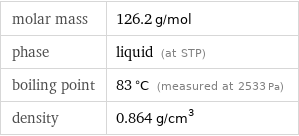
molar mass | 126.2 g/mol phase | liquid (at STP) boiling point | 83 °C (measured at 2533 Pa) density | 0.864 g/cm^3
Units

Liquid properties (at STP)
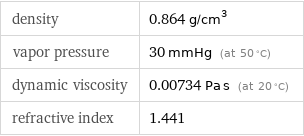
density | 0.864 g/cm^3 vapor pressure | 30 mmHg (at 50 °C) dynamic viscosity | 0.00734 Pa s (at 20 °C) refractive index | 1.441
Units

Chemical identifiers
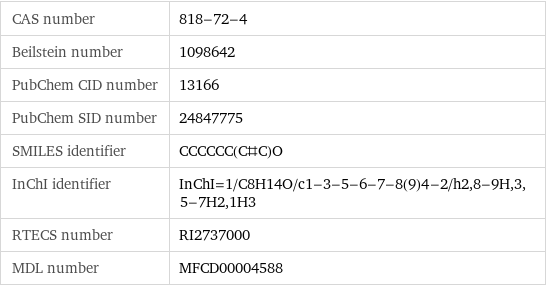
CAS number | 818-72-4 Beilstein number | 1098642 PubChem CID number | 13166 PubChem SID number | 24847775 SMILES identifier | CCCCCC(C#C)O InChI identifier | InChI=1/C8H14O/c1-3-5-6-7-8(9)4-2/h2, 8-9H, 3, 5-7H2, 1H3 RTECS number | RI2737000 MDL number | MFCD00004588
NFPA label

NFPA label

NFPA health rating | 3 NFPA fire rating | 2 NFPA reactivity rating | 0
Safety properties

flash point | 63.89 °C autoignition point | 315 °C

DOT hazard class | 6.1 DOT numbers | 2810
Toxicity properties

RTECS classes | drug